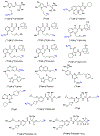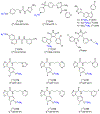The Repertoire of Small-Molecule PET Probes for Neuroinflammation Imaging: Challenges and Opportunities beyond TSPO
- PMID: 34905377
- PMCID: PMC9094091
- DOI: 10.1021/acs.jmedchem.1c01571
The Repertoire of Small-Molecule PET Probes for Neuroinflammation Imaging: Challenges and Opportunities beyond TSPO
Abstract
Neuroinflammation is an adaptive response of the central nervous system to diverse potentially injurious stimuli, which is closely associated with neurodegeneration and typically characterized by activation of microglia and astrocytes. As a noninvasive and translational molecular imaging tool, positron emission tomography (PET) could provide a better understanding of neuroinflammation and its role in neurodegenerative diseases. Ligands to translator protein (TSPO), a putative marker of neuroinflammation, have been the most commonly studied in this context, but they suffer from serious limitations. Herein we present a repertoire of different structural chemotypes and novel PET ligand design for classical and emerging neuroinflammatory targets beyond TSPO. We believe that this Perspective will support multidisciplinary collaborations in academic and industrial institutions working on neuroinflammation and facilitate the progress of neuroinflammation PET probe development for clinical use.
Conflict of interest statement
The authors declare no competing financial interest.
Figures














References
-
- Davalos D; Grutzendler J; Yang G; Kim JV; Zuo Y; Jung S; Littman DR; Dustin ML; Gan W-B ATP mediates rapid microglial response to local brain injury in vivo. Nat. Neurosci 2005, 8, 752–758. - PubMed
-
- Mantovani Alberto; Sica Antonio; Locati M Macrophage polarization comes of age. Immunity 2005, 23, 344–346. - PubMed
-
- Graeber MB Changing face of microglia. Science 2010, 330, 783–788. - PubMed
Publication types
MeSH terms
Substances
Grants and funding
LinkOut - more resources
Full Text Sources
Chemical Information
Research Materials

